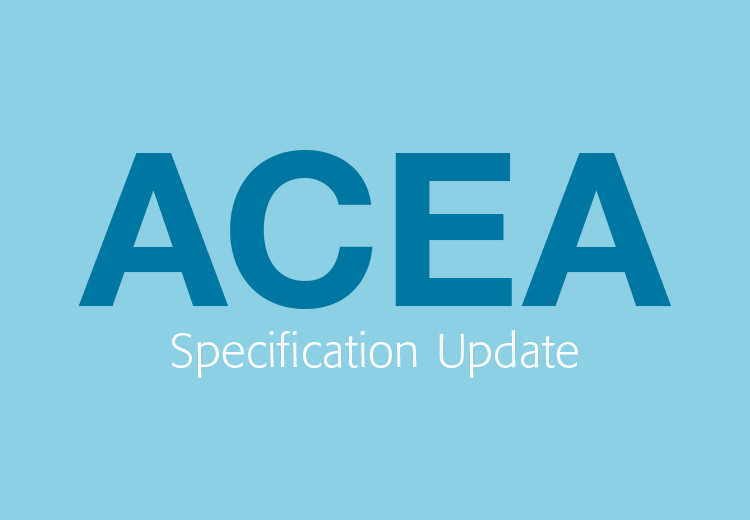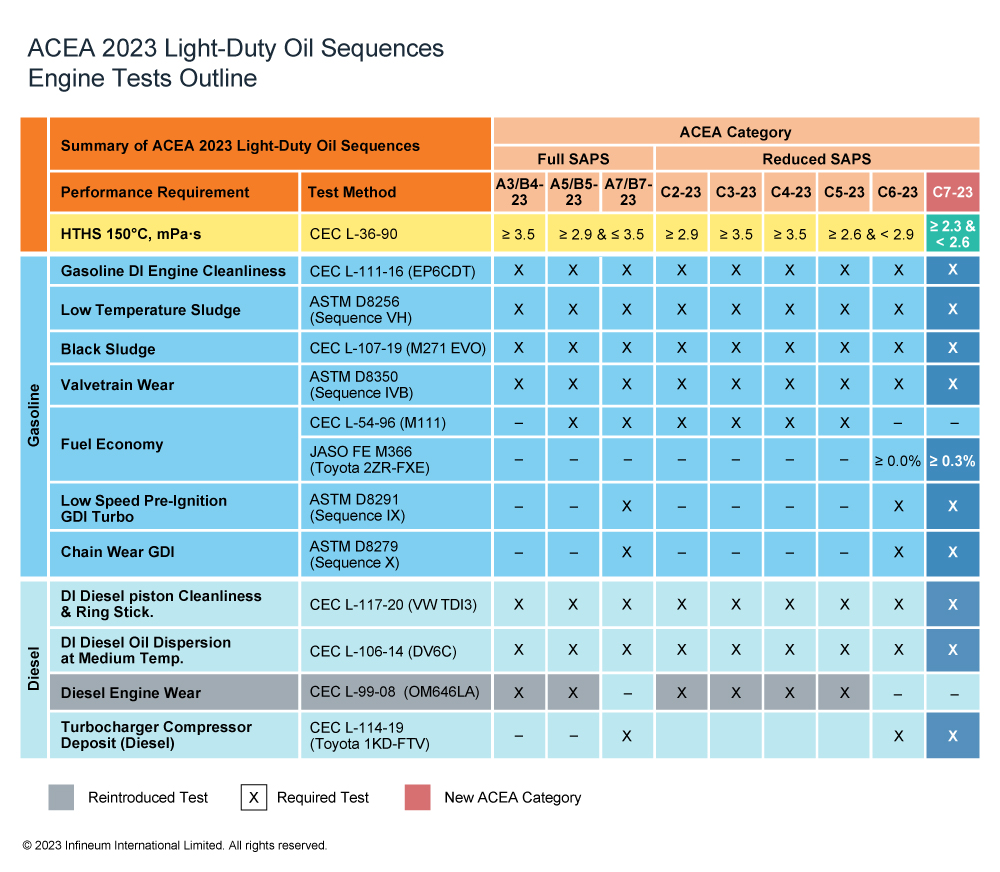Specification updates
The latest on PC-12
12 December 2023
01 August 2023
Key changes and their impacts on passenger car engine oil formulations

The European Automobile Manufacturers’ Association (ACEA) has been working on revisions to its European Oil Sequences for light-duty engines since early 2022. Following significant industry effort and collaboration, the new ACEA 2023 European Oil Sequences for light-duty engines are about to be released. Damien Bernard-Brunel, Infineum Industry Liaison Advisor, talks to Insight about their development and assesses the key implications for lubricant formulators.
The automotive industry is under increasing pressure to decarbonise – making fuel economy improvement high on the agenda for OEMs. With this in mind, it’s hardly surprising that fuel economy was the biggest motivator for the latest revisions to the ACEA light-duty (LD) Sequences.
One of the key changes being introduced is the new ACEA C7 category, which provides enhanced fuel economy via the low viscosity SAE 0W-16 grade.
In addition to this activity, there were some concerns about the availability of test hardware that needed to be resolved. Despite some delays, ACEA says it is committed to maintaining the intended release timing of August 2023.
Initially ACEA had proposed to withdraw the Gasoline DI engine cleanliness (EP6CDT) and DI diesel oil dispersion at medium temperature (DV6C) tests as it was thought that the long-term availability of these engines could not be guaranteed. However, Coordinating European Council (CEC), which manages these test methods, has now informed the industry that the EP6CDT and DV6C hardware has been secured for a few more years, allowing both of these tests to be retained in the 2023 revision.
As industry discussions picked up in early 2023, ACEA said it would like to reintroduce the engine wear and biodiesel-compatibility tests based on the OM646LA hardware. These were both removed from the ACEA 2021 revision as their lifetime could not be guaranteed beyond the end of 2022. It now seems that this hardware will be available past 2026. While the Additives Technical Committee (ATC) and the Technical Association of the European Lubricants Industry (ATIEL) accepted the reintroduction of the wear test, they argued that the piston cleanliness parameter in this test could be used to alleviate the need for the biodiesel test. ACEA accepted their recommendation and will only reintroduce the OM646LA wear test.
One of the key changes in the new ACEA LD Sequences is the introduction of the ACEA C7 category. This is derived from ACEA C6 for most requirements, except for the further fuel economy improvement, enabled by the use of the SAE 0W-16 viscosity grade. ACEA’s vision for this category was that, by starting from existing ACEA C6 technologies, ACEA C7 oil formulations should be readily achievable and rapidly available in the market following the publication of ACEA 2023.
ACEA initially proposed a limit for the JASO M366 fuel economy improvement test (JASO-FE) of +0.5% vs a SAE 0W-20 reference oil. It was felt by some stakeholders, including Infineum, that this was quite ambitious considering known trade-offs with other engine tests (e.g. VW TDI and the Toyota Turbocharger tests) or new challenges particularly on wear protection in the thin SAE 0W-16 viscosity grade. In January 2023, ACEA proposed a revised straw man of the LD sequences, clarifying that the first JASO-FE limit was a suggestion, and that alternative proposals, supported by data, would be welcomed.
ATC-PTS (Performance Testing Subcommittee) then collected results for the JASO-FE test across various additive technologies. Although no consensus could be reached within ATC-PTS, statistical analysis confirmed the initial assessment that 0.5% may be too severe and 0.3% would be a more meaningful limit in support of ACEA’s initial vision and this data was accepted by ACEA.
The new limit for the JASO-FE test in the ACEA C7 category has been agreed as +0.3%.
The final draft of the ACEA 2023 LD Sequences was circulated in early June 2023. ATC and ATIEL have provided feedback and suggestions that were mostly cosmetic in nature. ACEA is now working on editing the final version with the intention to release the revisions in August 2023. A summary of the engine test requirements for the ACEA LD Sequences is shown below.

Formulations that were developed before 2021 are generally unaffected by this latest ACEA revision since most of the ACEA categories have not really changed.
While the OM646LA test will reappear in ACEA 2023 it is likely that only newer products, developed between 2021 and today, might require a result in this wear test. And, this may be the case only for products that solely target ACEA categories, since many European OEMs had retained the OM646 wear test in their in-house specifications over the past two years, even though it had been removed from the ACEA LD Sequences. This means that some limited testing activity may be required.
However, the Candidate Data Packages (CDP) for ACEA 2021 must now be updated to include the OM646 wear test. This will affect the entire light-duty engine oil product line regardless of when the lubricant formulations were developed, which means it may take some time. This activity must be completed within two years, which is the period during which engine oils with ACEA 2021 claims can still be marketed.
Infineum has already assessed how to include the new ACEA C7 category in our product slate and will be ready to offer solutions to our customers when the demand for such lubricants arises.
While it has been a challenge to finalise these revisions to the ACEA LD Engine Oil Sequences there are no surprises and the workload to upgrade products should be minimal. But, in an industry full of change in terms of decarbonisation targets and new emissions standards, we have to wonder when new requirements for the next revision will start to emerge.
Sign up to receive monthly updates via email